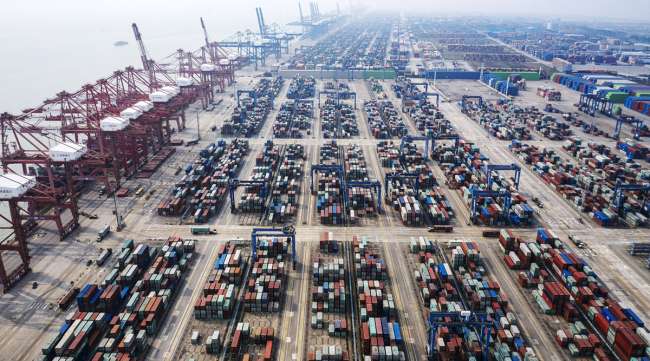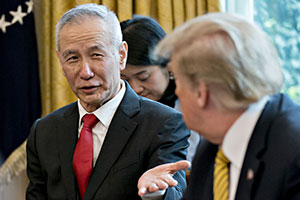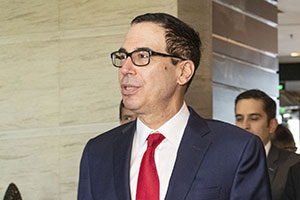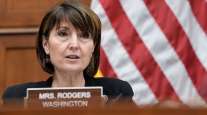China Prepares Retaliatory Tariffs as Chief Negotiator Heads to US

China’s top trade negotiator Liu He will travel to the United States this week for high-stakes talks as prospects dimmed for maintaining a fragile truce after President Donald Trump threatened to raise tariffs on Chinese goods starting May 10.
Vice Premier Liu will meet with U.S. Trade Representative Robert Lighthizer and Treasury Secretary Steven Mnuchin, on May 9-10, according to a statement May 7 on the Chinese Ministry of Commerce website. At the same time, China is preparing retaliatory tariffs on U.S. imports should Trump carry out his threat, according to people familiar on the matter.
U.S. equity-index futures extended declines as investors weighed potential setbacks in negotiations that both sides had indicated in recent weeks were headed in the right direction. The dollar edged higher as Treasury yields were steady.
The latest twist sets up May 9 as a crucial moment in the yearlong trade war with potentially huge ramifications for companies, markets, consumers and politicians in both nations. In light of the U.S. ultimatum, attention will turn to whether Liu offers enough concessions to stave off higher tariffs or whether China plays hardball with retaliatory measures.

China Vice Premier Liu He has been in several meetings with President Donlad Trump over China trade. (Andrew Harrer/Bloomberg News)
“The fact that China sends a delegation to the U.S. shows it is still willing to solve the dispute by negotiations regardless of what the U.S. is saying,” said Lu Xiang at the state-run Chinese Academy of Social Sciences in Beijing. “If the Trump administration follows through with the tariffs threats on May 10, I think it means the talks fall apart. We then need to be prepared for worse than worst.”
China would make its retaliatory tariffs effective one minute after the United States, if the decision to add an extra 25% in duties on $200 billion of Chinese imports comes into force, the sources said, who asked not to be identified as the matter isn’t public. The State Council and Commerce Ministry didn’t respond to requests for comment on the tariff plans.
The trade talks were cast into doubt after Trump’s surprise announcement over Twitter on May 5 that he planned to raise the tariff increase from the current 10% because talks were moving too slowly. The president said he also may impose duties “shortly” on $325 billion of Chinese goods that aren’t currently covered, a move that would hit virtually all imports from the Asian nation.

Treasury Secretary Steven Mnuchin (Gilles Sabrie/Bloomberg News)
The Trump administration plans to increase duties on Chinese imports at 12:01 a.m. on May 10, Lighthizer said May 7. “We felt we were on track to get somewhere. Over the course of last week we have seen an erosion of commitments by China. That in our view is unacceptable,” he said, adding that significant issues remain unresolved, including whether tariffs will remain in place.
China was “well prepared for other potential outcomes” of its trade talks with the United States, “including a temporary breakdown in talks,” the Global Times newspaper said in an editorial May 7. The door wasn’t closed to talks even if the U.S. raises tariffs, the newspaper said.
Lighthizer and Mnuchin told reporters May 6 that the Chinese backsliding became apparent during their visit to Beijing last week but that they had been reassured by their Chinese interlocutors that everything would turn out.

U.S. Trade Representative Robert Lighthizer (Andrew Harrer/Bloomberg News)
That changed over the weekend when China sent through a new draft of an agreement that included them pulling back on language in the text on a number of issues, which had the “potential to change the deal very dramatically,” Mnuchin said. At that stage, about 90% of the pact had been finalized, he said, and the Chinese wanted to reopen areas that already had been negotiated.
“We are not willing to go back on documents that have been negotiated in the past,” he said.
According to two sources familiar with the U.S.’position, China backtracked on committing to legal changes that American officials saw as key to selling the deal domestically as the biggest concession any U.S. administration has ever gotten from China.
This isn’t the first time an apparent agreement faltered. A year ago, Liu told reporters in Washington that talks with Mnuchin, Lighthizer and Secretary of Commerce Wilbur Ross ended with a pledge not to engage in a trade war.




